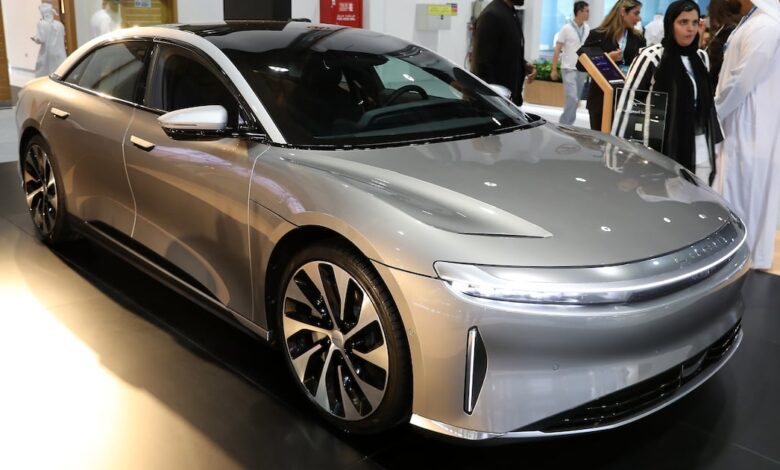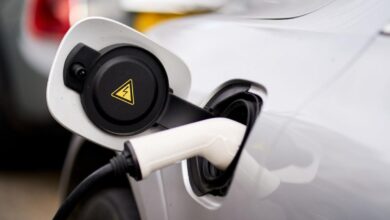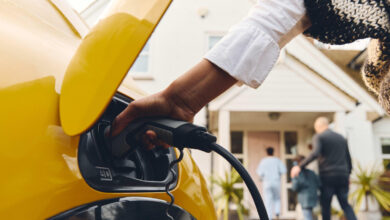Electric vehicles to account for 25% of all new sales in the UAE by 2035, PwC says

The adoption of electric vehicles is expanding in the UAE and could account for up to 25 per cent of all new passenger cars and light commercial vehicle sales by 2035 amid the country’s decarbonisation efforts, a report has found.
EVs will have a market share of more than 15 per cent of all sales in the UAE by 2030, and could reach approximately 110,500 vehicles five years later, PwC’s recently released Mobility Outlook report found.
Currently, EVs – also known as battery electric vehicles – represent 3 per cent of all vehicles sold in the UAE, the report said, with internal combustion engine vehicles dominating the market.
The growth projections are contingent on several factors such as an increased variety in EV model offerings, charging infrastructure investments and the total cost of EV ownership continuing to decline, according to the report.
Battery electric vehicles currently make up 7 per cent of the cars offered by UAE dealers, as compared to 26 per cent in Europe.
“While all these car options are available in the world, they’re not necessarily available here [in the UAE],” said Heiko Seitz, PwC’s global and Middle East e-mobility leader.
“If you want to make e-mobility work in the Middle East, you also have to provide all the different car models to the users they want to buy,” he added.
Mr Seitz expects to see more EV models, particularly from Chinese companies, available in the UAE and throughout the Middle East in the years ahead.
Despite the need for greater EV options, Mr Seitz said that both the UAE and Saudi Arabia have the benefit of being “wave II” countries for electric vehicle adoption, following “wave 1″ countries, such as the US, China and those in Europe.
“The UAE and Saudi Arabia are in a good position of being able to identify what worked and what didn’t work compared to those other countries,” he said.
“While they’re 10 years behind, you’re going to see this region reach EV maturity much faster compared to other regions because you can skip the learning curve,” he said.
As a result, the EV ecosystem in the Middle East will evolve more rapidly, be more profitable and stay customer-centric.
PwC’s report acknowledged the UAE for identifying EVs and e-mobility as a priority policy area.
“Under the Energy Strategy 2050, the country is pursuing a combination of renewable and nuclear energy sources to achieve carbon neutrality by the middle of this century,” the report said.
“The adoption of electric vehicles is a critical element in this transition to a low carbon economy.”
When the UAE hosted the Cop28 climate conference in 2023, the UAE announced revised goals which aim to have 50 per cent of cars on the country’s roads being EVs to help reduce carbon emissions.
Need for charging stations
According to the report, one of the main obstacles to the widespread adoption of EVs in the UAE, and globally, continues to be concern about charging stations.
Despite rapid advancements in EV battery technology, customers still have concerns about being able to find charging points for their vehicles on lengthy journeys. This has been dubbed “range anxiety” by automotive analysts.
“The gap between the current roll-out speed of public charging infrastructure and demand is set to grow,” the report said.
There are approximately 2,000 public charge points deployed throughout the UAE currently, according to PwC.
“Demand is forecast to reach 45,000 charge points by 2035 if the UAE’s National Electric Vehicles Policy target for the share of EVs on the road is to be met,” the report said.
“However, at the current rate of rollout there will only be 10,000 charge points in the UAE by 2035.”
Expansion of public charging infrastructure should be prioritised in less populated and rural areas to help address concerns, PwC said.
To address the growing demand for charging points, the UAE Ministry of Energy and Infrastructure and Etihad Water and Electricity recently announced a joint venture called UAEV, a charging network fully owned and operated by the government.
Driving down costs
Although there is increased parity in terms of the total cost of ownership for EVs when compared to internal combustion engine vehicles, the initial upfront cost and insurance rates for electric vehicles remain high.
For commercial buyers of EVs in the UAE, however, PwC said there’s actually a cost advantage.
“Vehicles are typically discounted, particularly for fleet customers who are regarded as pivotal clients and enjoy even greater discounts,” the report said.
Eventually, with more EV choices available in the UAE and the operating costs becoming cheaper compared to ICE vehicles, Mr Heiko said making the switch to EVs will be more appealing.
“We expect more and more models … And the total cost of ownership is probably going to reduce significantly,” he said.
EVs have a lower carbon footprint when compared to ICE vehicles, but even with increased adoption, it might not be enough to significantly reduce overall carbon emissions.
“To achieve significant emissions cuts, the UAE will need to increase the share of green energy sources including renewables and nuclear power,” the report said.
In terms of nuclear energy, as of March, the fourth and final unit of the country’s Barakah Nuclear Energy Plant was connected to the UAE power grid, bolstering the UAE’s clean energy capacity.
The UAE is also adding solar and wind energy capacity as part of its transition efforts. As of 2023, the country ranked second in the world for per capita solar energy consumption, according to the Statistical Review of World Energy.
“There’s a huge difference if I fuel my EV with power made from grey energy [fossil fuels], compared to green energy,” said Mr Heiko.
“So, if I really want to achieve the maximum effect on reducing carbon dioxide emissions, we can do that significantly if we have a green EV fuelled by green energy.”
Energy sources powering EVs and the rest of the power grid are often overlooked in the energy transition discussion, Mr Heiko said.
“It’s one thing to electrify e-mobility, it’s another thing to decarbonise.”
Updated: June 17, 2024, 6:37 AM



